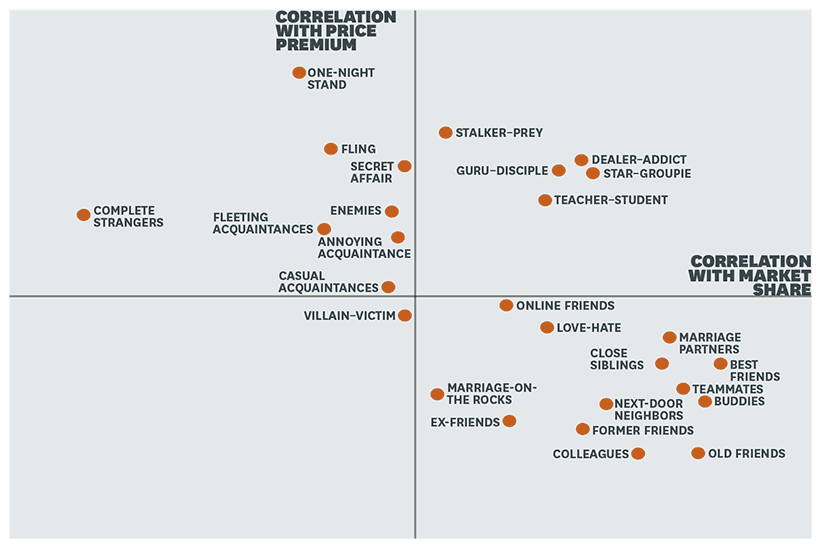How (not) to burn your customers’ trust and loyalty in 48 hours
Align your relationship expectations with your customersProtesters in the streets. Current and former employees lambasting you and your team on live television. The Prime Minister himself condemning your strategy.
And it all could have been easily avoided with a few conversations with key stakeholders.
The rise and fall of the Super League — a proposed new European soccer league — is a tale worth reading, and we’ll leave it to others to tell the full story. But today, let’s focus on one key angle: Why studying your customers, and specifically the relationship you have with them, is so important before any new initiative.
In 2014, Harvard Business Review published a study worth considering: “Unlock the Mysteries of Your Customer Relationships.” Researchers identified 29 distinct types of relationships with evocative names such as “Dealer-Addict,” “Old Friends,” “Villain-Victim,” and even “One-Night Stand.”

What brand doesn’t want to be “Best Friends” with its customers? Which brand managers don’t have sleepless nights worrying about ending up as an “Annoying Acquaintance?” The point is that the relationship one brand has with its customers could be drastically different from another brand’s. And it’s critical to know the kind of relationship your customers expect.
Consider a utility company trying to create a “Best Friends” relationship with its customers. Tough, right? Don’t get me wrong, it might be possible given the right circumstances (and an all-star team and strategy), but most people just want a simple exchange of money for electricity or water.
How about a luxury brand treating its customers as “Complete Strangers”? We’d guess that relationship wouldn’t last long after the first transaction. Its customers are more likely to demand quite a bit of love and attention.
Now how did things go wrong for the Super League? Owner and fan expectations of their mutual relationship were totally off-sync. Let us explain.
You don’t find or choose a relationship in a vacuum. You learn about it from talking to your stakeholders: management, employees, customers, prospects. You learn about it from studying your customers’ attitudes and behaviors online — on social media and forums — as audience research. These things can give you smart insights about what customers expect as part of that brand-customer relationship, based on the long-term interactions a brand has with its customers over a span of years.
After the fact, the word from several teams was that no stakeholders — even internal — were consulted on whether the Super League made sense as a strategy. Owners made this plan in secret, consulting only external management advisors and financiers, and assuming that their teams would have enough support to weather the storm of criticism from other teams.
Since there were no consultations, owners didn’t realize how hostile their own fans would be to the idea of a Super League. In Europe, we think it’s fair to say that fans see themselves to be as much a part of the teams as the players are. In most cases, teams go back a century or more to local workers’ clubs: Take Arsenal’s origin among munitions workers who formed a team named after a workshop in the Royal Arsenal. To put it in terms of the HBR research, fans expected to be something akin to “Marriage Partners” — to be inextricably linked, co-equal stakeholders in the team. And, critically, as stakeholders who believed in the merits of the existing league system.
However, owners saw them, and treated them, at best as “Star-Groupies”, thinking the star (the owners) controlled the direction of the team, and the groupies (the fans) would be happy to just follow them to the Super League. That’s a totally different dynamic — an “owners know best” style of thinking — and shocking for fans who were more than happy to express their disapproval.
But it’s not a shock to us that a lack of communication would cause such a misstep.
When we start working with clients, we typically develop a Content Playbook that identifies the whitespace between a brand and its customers — how, when and why it makes sense to engage them with a content marketing strategy. That Playbook is fueled by stakeholder interviews, data and audience research.
This work inevitably trends into relationship expectations: What do customers want and expect from a brand? It’s a must-have for any marketing strategy. How could you expect to be relevant otherwise?
Given the money and stakes involved, we’d be surprised if this is the last we hear of an attempt to create an exclusive European Super League. But every business can learn from this failed experiment — it’s critical to first find out what your customers want and expect before taking drastic action. R
Subscribe
Get our weekly newsletter for tips on how to drive better content marketing performance.
For a regular stream of ideas, research and links we find helpful. And of course, to say hi!
